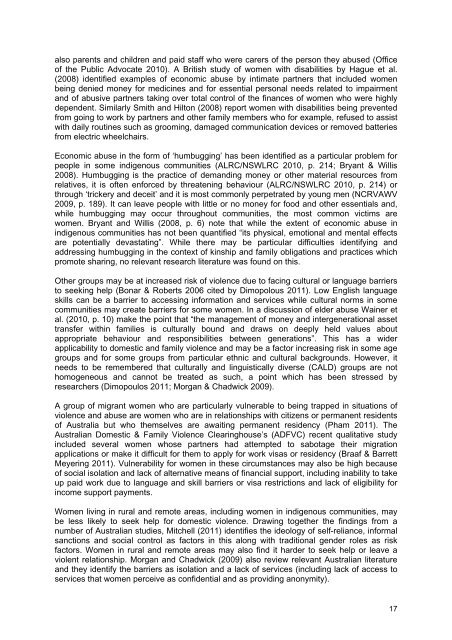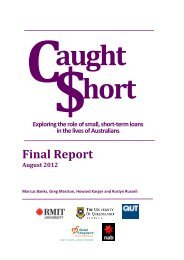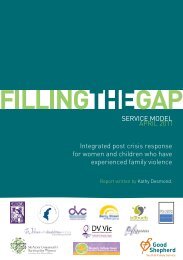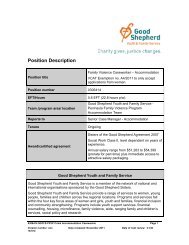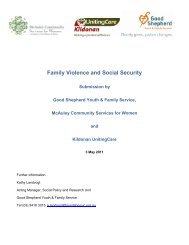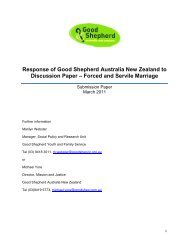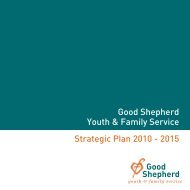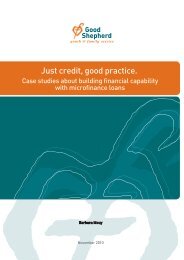Spotlight on Economic Abuse: a Literature and Policy Review
Spotlight on Economic Abuse: a Literature and Policy Review
Spotlight on Economic Abuse: a Literature and Policy Review
Create successful ePaper yourself
Turn your PDF publications into a flip-book with our unique Google optimized e-Paper software.
also parents <strong>and</strong> children <strong>and</strong> paid staff who were carers of the pers<strong>on</strong> they abused (Office<br />
of the Public Advocate 2010). A British study of women with disabilities by Hague et al.<br />
(2008) identified examples of ec<strong>on</strong>omic abuse by intimate partners that included women<br />
being denied m<strong>on</strong>ey for medicines <strong>and</strong> for essential pers<strong>on</strong>al needs related to impairment<br />
<strong>and</strong> of abusive partners taking over total c<strong>on</strong>trol of the finances of women who were highly<br />
dependent. Similarly Smith <strong>and</strong> Hilt<strong>on</strong> (2008) report women with disabilities being prevented<br />
from going to work by partners <strong>and</strong> other family members who for example, refused to assist<br />
with daily routines such as grooming, damaged communicati<strong>on</strong> devices or removed batteries<br />
from electric wheelchairs.<br />
Ec<strong>on</strong>omic abuse in the form of ‘humbugging’ has been identified as a particular problem for<br />
people in some indigenous communities (ALRC/NSWLRC 2010, p. 214; Bryant & Willis<br />
2008). Humbugging is the practice of dem<strong>and</strong>ing m<strong>on</strong>ey or other material resources from<br />
relatives, it is often enforced by threatening behaviour (ALRC/NSWLRC 2010, p. 214) or<br />
through ‘trickery <strong>and</strong> deceit’ <strong>and</strong> it is most comm<strong>on</strong>ly perpetrated by young men (NCRVAWV<br />
2009, p. 189). It can leave people with little or no m<strong>on</strong>ey for food <strong>and</strong> other essentials <strong>and</strong>,<br />
while humbugging may occur throughout communities, the most comm<strong>on</strong> victims are<br />
women. Bryant <strong>and</strong> Willis (2008, p. 6) note that while the extent of ec<strong>on</strong>omic abuse in<br />
indigenous communities has not been quantified “its physical, emoti<strong>on</strong>al <strong>and</strong> mental effects<br />
are potentially devastating”. While there may be particular difficulties identifying <strong>and</strong><br />
addressing humbugging in the c<strong>on</strong>text of kinship <strong>and</strong> family obligati<strong>on</strong>s <strong>and</strong> practices which<br />
promote sharing, no relevant research literature was found <strong>on</strong> this.<br />
Other groups may be at increased risk of violence due to facing cultural or language barriers<br />
to seeking help (B<strong>on</strong>ar & Roberts 2006 cited by Dimopolous 2011). Low English language<br />
skills can be a barrier to accessing informati<strong>on</strong> <strong>and</strong> services while cultural norms in some<br />
communities may create barriers for some women. In a discussi<strong>on</strong> of elder abuse Wainer et<br />
al. (2010, p. 10) make the point that “the management of m<strong>on</strong>ey <strong>and</strong> intergenerati<strong>on</strong>al asset<br />
transfer within families is culturally bound <strong>and</strong> draws <strong>on</strong> deeply held values about<br />
appropriate behaviour <strong>and</strong> resp<strong>on</strong>sibilities between generati<strong>on</strong>s”. This has a wider<br />
applicability to domestic <strong>and</strong> family violence <strong>and</strong> may be a factor increasing risk in some age<br />
groups <strong>and</strong> for some groups from particular ethnic <strong>and</strong> cultural backgrounds. However, it<br />
needs to be remembered that culturally <strong>and</strong> linguistically diverse (CALD) groups are not<br />
homogeneous <strong>and</strong> cannot be treated as such, a point which has been stressed by<br />
researchers (Dimopoulos 2011; Morgan & Chadwick 2009).<br />
A group of migrant women who are particularly vulnerable to being trapped in situati<strong>on</strong>s of<br />
violence <strong>and</strong> abuse are women who are in relati<strong>on</strong>ships with citizens or permanent residents<br />
of Australia but who themselves are awaiting permanent residency (Pham 2011). The<br />
Australian Domestic & Family Violence Clearinghouse’s (ADFVC) recent qualitative study<br />
included several women whose partners had attempted to sabotage their migrati<strong>on</strong><br />
applicati<strong>on</strong>s or make it difficult for them to apply for work visas or residency (Braaf & Barrett<br />
Meyering 2011). Vulnerability for women in these circumstances may also be high because<br />
of social isolati<strong>on</strong> <strong>and</strong> lack of alternative means of financial support, including inability to take<br />
up paid work due to language <strong>and</strong> skill barriers or visa restricti<strong>on</strong>s <strong>and</strong> lack of eligibility for<br />
income support payments.<br />
Women living in rural <strong>and</strong> remote areas, including women in indigenous communities, may<br />
be less likely to seek help for domestic violence. Drawing together the findings from a<br />
number of Australian studies, Mitchell (2011) identifies the ideology of self-reliance, informal<br />
sancti<strong>on</strong>s <strong>and</strong> social c<strong>on</strong>trol as factors in this al<strong>on</strong>g with traditi<strong>on</strong>al gender roles as risk<br />
factors. Women in rural <strong>and</strong> remote areas may also find it harder to seek help or leave a<br />
violent relati<strong>on</strong>ship. Morgan <strong>and</strong> Chadwick (2009) also review relevant Australian literature<br />
<strong>and</strong> they identify the barriers as isolati<strong>on</strong> <strong>and</strong> a lack of services (including lack of access to<br />
services that women perceive as c<strong>on</strong>fidential <strong>and</strong> as providing an<strong>on</strong>ymity).<br />
17


